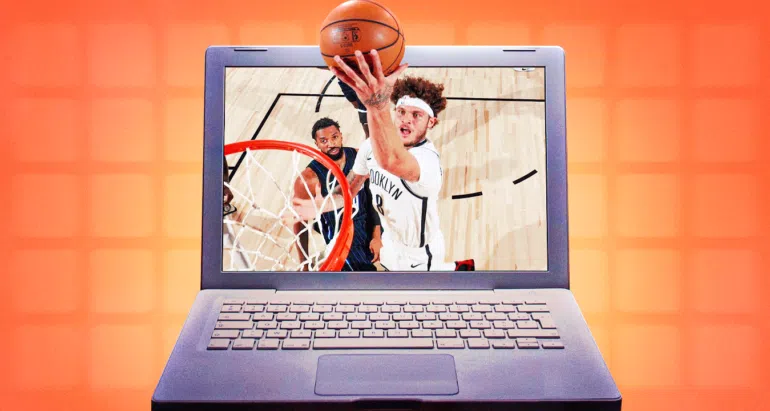The NBA overcame various challenges and numerous sacrifices to ensure a safe playing and living environment in the Orlando “bubble” at Disney World. One of the most noticeable sacrifices from a viewing perspective is the absence of fans in the stands, the harsh financial reality of a world controlled by the novel coronavirus.
In light of this fan-less development, the NBA announced the next-best idea: virtual participation. What exactly does that mean? Allow me to explain. On the NBA Disney Campus, there are three arenas: The HP Fieldhouse, the Arena, and the Visa Athletic Center. Each arena is outfitted with large screens behind both baselines and the sideline neighboring team benches.
NBA announces that 300 fans each game will be invited to be "virtual fans" on the 17-foot video boards that Michelob Ultra is sponsoring. pic.twitter.com/UwiEGJYhjB
— Mark Medina (@MarkG_Medina) July 24, 2020
During game play, fans on a video call are put onto these screens and into virtual “chairs” to react to the game action on the court. Naturally, you have some questions considering the complexity of the entire process. I’ll do my best to explain how everything works from a fan’s perspective and from a technical one, as well as answer every question I got on Twitter. A quick disclaimer before we begin: I attended the Nets vs Kings game as a Nets fan, and this experience could be different for other teams.
How Does It All Work?
This is (by far) the most recurring question. Simply put, each screen – or “section” – is a separate Microsoft Teams video call with about 40 people attending. There are three Nets staff members there to moderate behavior and ensure all fans are presentable for National Television.
As you join the call, you are randomly assigned a seat. The absence of seating assignments is relatively insignificant, with one exception: celebrities. During the Nets vs. Kings game, the two celebrities virtually viewing the game were Andrew Yang (former presidential candidate) and Micheal Ray Richardson (Nets Point Guard, first all-time in steals). Richardson was in my section/call, and he was shown on YES alongside the fans sitting next to him.
The technical specifics are quite simple, actually. Each fan is emailed login information for a Microsoft Teams account, and you are asked to join the call a half hour before tip-off. In that half-hour, moderators help fans get accustomed with the interface, and go over the rules and guidelines (more on that later).
As the game goes on, fans react according to game action. The feed we receive is about 8 seconds ahead of the television broadcast, clearly an effort to emulate the “live” feeling of being at an NBA game.
Do you just watch the same game we’re seeing, or do you actually get your own “view”?
Unfortunately not. Upon joining the Microsoft Teams call, one of the accounts already there is a game feed of the local TV broadcast, YES in our case. For me, that’s the best of both worlds. I wish I could hear Ian Eagle at Barclays!
And what are the “rules”? Are there rules? Are you allowed to step away?
Yes, there are rules. However, nothing asked of fans is out of the ordinary. After all, there is a code of conduct for fans at NBA games, which happens to be one of the rules; “Violations of the rules outlined in the Fan
Code of Conduct may result in a warning and/or ejection from the game.”
Remember, the NBA wants to keep the fan experience as authentic as possible, for both the fans participating and watching. To keep the authenticity, fans were reminded multiple times to only have 1 fan per virtual seat, to sit up, and if necessary moderators would remind fans not to get too close to the camera.
Moderators informed us all not to step away from our cameras or we would be subject to temporary removal, with the goal of keeping as many seats full as possible. Of course, during time-outs and half-time fans were encouraged to excuse themselves.
I thought I noticed my guy @Keith_McPherson in my section… pic.twitter.com/7ntwLVJNfR
— Alec Sturm (@Alec_Sturm) August 7, 2020
Do you actually feel immersed in the experience?
This is a tough one. Amid their best efforts, nothing can truly recreate the energy of a real, live, NBA arena, packed with tens of thousands of fans cheering for their favorite team. However, I felt immersed in a whole new experience, one entirely created for the NBA restart. I felt part of something new and cool, a different way of granting access to fans to the adventure that is an NBA game.
Are you able to interact with other virtual fans or is it just like watching on tv?
Technically, yes. Since all the fans are on a call together, we could – in theory – talk to one another. Unfortunately, this would only be possible during aforementioned breaks, and everyone’s microphone was kept off during game action.
I hope you have a better understanding of how the virtual fan experience works and a greater appreciation for those who make it happen as we wrap up this odd NBA year. The NBA is truly making the best with the tools at their disposal.

